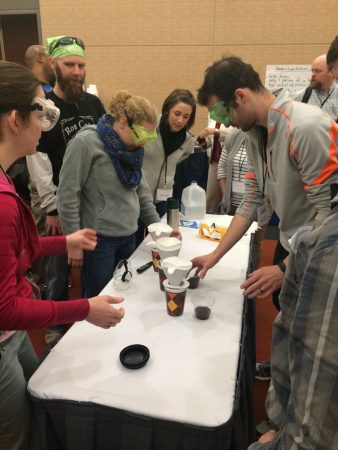Brewing a cup of chemistry
Combination of engineering and chemistry offers lesson in solubility
BOSTON ̶ There are two ways to teach solubility. You can go through the textbook, run the equations and then have students apply those equations to daily situations. Or — better yet — you can have students discover solubility for themselves. All it takes is a cup of coffee.
Andrew West and Aaron Sickel want to help students understand solubility using reverse engineering. West teaches science education at Western Kentucky University in Bowling Green. Sickel teaches it at Ohio University in Athens.
Both seek to combine engineering education with other subjects to help increase student understanding. “A lot of us,” Sickel explains, “were not trained specifically in engineering education, so we’re looking for effective ways to teach to the new standards.”

The demonstration began with a series of questions: How do you make a good cup of coffee? What ingredients and processes are necessary? What processes are optional? After the teachers discussed various aspects of a good brew, West and Sickel boiled a cup of coffee down to its essentials: water, ground coffee, a filter and heat. Now, they asked: What proportions of each are required to make the best java?
West and Sickel explored this through an experiment that examined the effects of variations in temperature. They made pour-over style coffee ̶ in which the water is pour directly over the grounds and allowed to seep into the cup below with nothing more than gravity. Different batches used cold, warm and hot water. Each time, they carefully measured temperature. Then the teachers were invited to taste the results.
“This is an introduction to solubility that gets at factors that affect it; water temperature, size, water-to-coffee ratio and brewing time,” West explained. Any of these variables easily could be tested in a classroom.
The results help students understand the factors that can influence solubility. The experiment also makes kids think about the engineering required to make a coffee pot that consistently brews a good cup of joe. “The engineering doesn’t just happen at the end,” West points out. The coffee project helps to show that science and engineering are intimately connected.
Of course, teachers might not want students heading off to the next class highly caffeinated. That’s why West and Sickel point out that the experiment should also work with decaf coffee and regular or herbal teas. It’s a simple experiment that helps students understand concepts as they perform the test. All it requires is ground plant material (aka coffee beans), water, heat, a filter and some engaged young minds.
Power Words
caffeine A stimulant, which activates the nervous system and heart. The leaves, seeds and fruits of many plants contain caffeine. In coffee plants and tea bushes, caffeine acts as a natural pesticide. It will kill or harm insects that attempt to dine on the plant. Caffeine is also toxic to some types of plants, bacteria — even frogs and dogs.
engineering The field of research that uses math and science to solve practical problems.
solubility A measure of the ability of one chemical to dissolve into another, creating a chemical solution.
Follow Eureka! Lab on Twitter: @Eureka_Labs